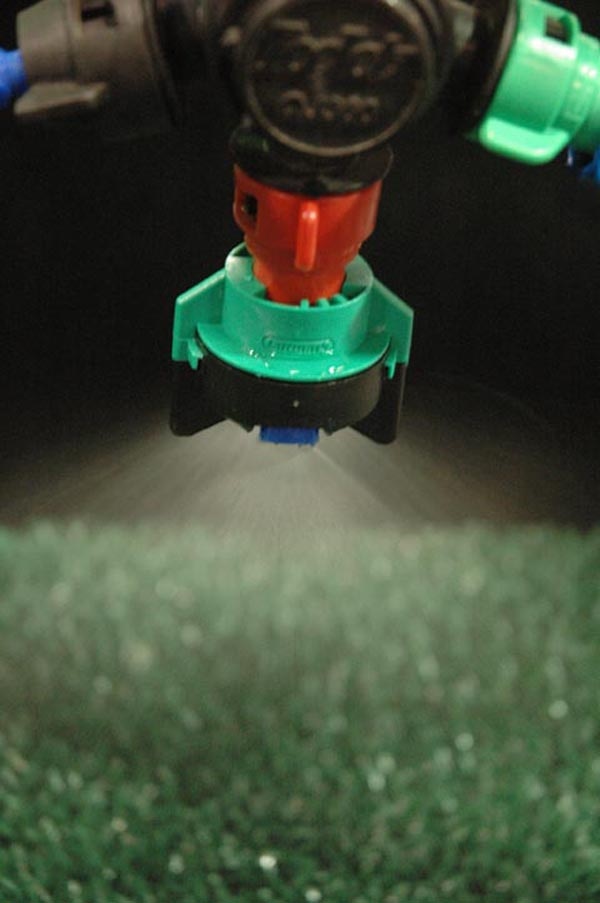April 19, 2017

Cropping systems based on the auxin-containing herbicides dicamba and 2,4-D offer new control options in the battle against glyphosate-resistant broadleaf weeds. According to research published in the journal Weed Science, though, it is important for growers using auxins to take precautions. Residues of the herbicide retained by certain types of applicator hoses can injure sensitive crops.
Depending on the amount of residue and the growth stage of the plant at the time of application, the impact on soybeans can range from cosmetic leaf injury to 80 percent yield loss.
The multiyear research project featured by the journal evaluated the amount of dicamba retained by five types of application hoses: PVC, polyethylene, polyurethane, PVC/polyurethane blends and synthetic rubber. Researchers also explored whether cleaning sprayers with water alone or with water plus ammonia made a difference in the amount of dicamba residue each type of hose retained.
The PVC/polyurethane blend and synthetic rubber hoses were found to retain the most dicamba analyte - producing the greatest soybean injury and the greatest reductions in height, dry matter and yield. The polyethylene hoses retained the least dicamba analyte. While cleaning the hoses decreased residues in all hose types, no differences were observed between adding ammonia to the cleanout solution versus using water alone.
Researchers say differences in the amount of dicamba analyte retained by various hose types may be attributable to the manufacturing process, the internal chemical composition of the hoses and how quickly that composition breaks down. Scans conducted with electron microscopy showed there were imperfections in new PVC polyurethane and synthetic rubber hoses that could deplete the inner wall. The polyethylene blend hoses were smooth and free of imperfections.
"The findings produced by the study can be especially helpful to producers who use a single sprayer to treat multiple crops and transgenic traits," says research team member Daniel B. Reynolds, Ph.D., of Mississippi State University. "Using polyethylene hoses may help to ensure a more thorough cleanout of dicamba before treating sensitive crops."
Access the full paper
Full text of the article "Evaluation of Dicamba Persistence Among Various Agricultural Hose Types and Cleanout Procedures Using Soybean (Glycine Max Merr.) as a Bio-Indicator" is now available in Weed Science Vol. 65, Issue 2, April-June, 2017.
About Weed Science
Weed Science is a journal of the Weed Science Society of America, a nonprofit scientific society focused on weeds and their impact on the environment. The publication presents peer-reviewed original research related to all aspects of weed science, including the biology, ecology, physiology, management and control of weeds.
https://www.cambridge.org/core/journals/weed-science
About the WSSA
The WSSA is a non-profit professional society, that promotes research, education, and extension outreach activities related to weeds; provides science-based information to the public and policy makers; and fosters awareness of weeds and their impacts on managed and natural ecosystems.
About Cambridge Journals
Cambridge University Press publishes over 370 peer-reviewed academic journals across a wide spread of subject areas, in print and online. Many of these journals are the leading academic publications in their field and together they form one of the most valuable and comprehensive bodies of research available today.
For further information about Cambridge Journals, go to: http://cambridge.org/core
About Cambridge University Press
Cambridge University Press is part of the University of Cambridge. It furthers the University's mission by disseminating knowledge in the pursuit of education, learning and research at the highest international levels of excellence.
Its extensive peer-reviewed publishing lists comprise 45,000 titles covering academic research, professional development, over 370 research journals, school-level education, English language teaching and bible publishing.
Playing a leading role in today's international market place, Cambridge University Press has over 50 offices around the globe, and it distributes its products to nearly every country in the world.
For further information, go to: cambridge.org
You May Also Like




